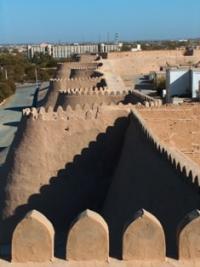You are here
Fortress Ichan Kala in Khiva.

Visit to historical monuments in Khiva.
"They forgot" the days of longing,
Night shouts: "To the gun!",
Moody Salts
And step dimensional camel,
Fields of unknown land
And the death of a company unhappy,
And Uch-kuduk, and Kinderley,
And the Russian flag on the white Khiva! ”
Nikolai Gumilyov. "Turkestan generals".
Drive from Khiva to Beyneu.
Itchan Kala is the inner town (protected by brick walls some 10 m high) of the old Khiva oasis, which was the last resting-place of caravans before crossing the desert to Iran. Although few very old monuments still remain, it is a coherent and well-preserved example of the Muslim architecture of Central Asia.
There are several outstanding structures such as the Djuma Mosque, the mausoleums and the madrasas and the two magnificent palaces built at the beginning of the XIXth century by Alla-Kulli-Khan coherent and globally preserved urban ensemble, the inner city of Khiva, Ichan Kala, bears exceptional testimony to the lost civilization of Khorezm.
Several monuments of Ichan Kala, such as the Djuma Mosque, constitute remarkable types of architectural ensembles, whereas the madrasas, of majestic proportions but simple in design, are exceptional examples of a type of Muslim architecture specific to central Asia.
The domestic architecture of Khiva is one of the major elements of interest of Ichan Kala by virtue of its design and its construction. Khiva oasis, which lies south of the Amu Darya river (the Oxus of the ancients), was the final halt for caravans before crossing the desert to Persia. In the IV-th century AD, the town was at the heart of Khorezm (Greek Choresmia), an Iranian kingdom whose prosperity was linked with the legendary efficient of its hydraulic techniques, which were capable of transforming the 'black sands' of the region into lush grazing lands, gardens, and orchards.
It was first conquered by the Arabs in 712, and then by the Mongols in 1221. In 1379 it fell into the hands of Timur (Tamerlane the Great), staying under Mongol control, until taken by Uzbeks in 1512, when it was the capital of the new state, and from 1643 of a khanate.
During the XIXth century it was independent, not becoming a Russian protectorate until 1873. The city, which is rectangular in plan, is divided into two parts: Dichan Kala, the outer town (formerly fortified), and Itchan Kala, the inner town with 10 m high walls.
Little has survived that is earlier than the XVIIth century, apart from the Djuma Mosque, although it was largely rebuilt in 1788 - 1789. Most of the public buildings are grouped round the main east-west axis, commanded at either end by the successive residences of the khans of Khiva.
To the north-west, Kunya Ark, the 'ancient fortress', was established in 1686 - 1688 by Arang-Khan; originally a formidable redoubt, it was converted in the early XIX-th century into a sumptuous palace by Alla-Ulli-Khan.
The Tach-Kauli Palace to the north-east, was built in 1830 - 1838, also for Alla-Ulli-Khan. Other exceptional monuments are the Mausoleum of Pahlavan Mahmud (1247 - 1325) and the Mausoleum of Sayid All-Uddin, which has retained its XIVth-century layout intact.
However, the outstanding qualities of Itchan Kala derive not so much from the individual monuments, splendid though many of them are, than from the incomparable urban composition of the city, and from the harmony with which the major constructions of the IXI-th and XX-th centuries were integrated into a traditional structure.
For example, south of Kunya Ark are to be found Kalta Minor and the Medresseh of Muhammad-Amin-Khan, while south-east of the Djuma Mosque and the Mausoleum of Pahlavan Mahmud is located the Medresseh of Islam-Khodja (1908 - 1910), with its elegant minaret, at 45 m the highest in Khiva.
The Medresseh of Alla-Kuli, built in 1835 in an awkward space near the east gate of the inner town, is a celebrated example of harmonious blending into an ancient urban fabric.
Authority:
«Religious and spiritual monuments of the Central Asia». The author of M. Khashimov. Publishing house "Saga", 2001. Belenitski A.M., Bentovitch I.B., Bolshakov O.G. « Medieval city of Central Asia»., 1973, Leningrad.
Photos
Alexander Petrov.







